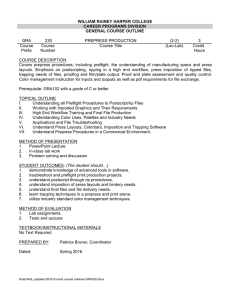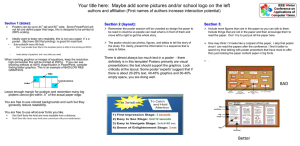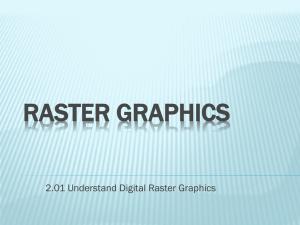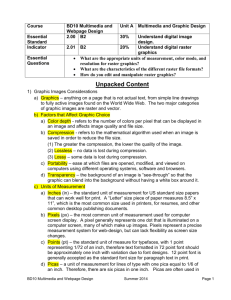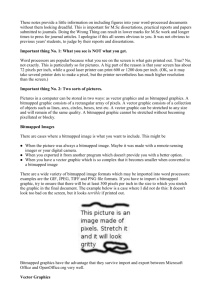ch9 - ArtWithFalk
advertisement
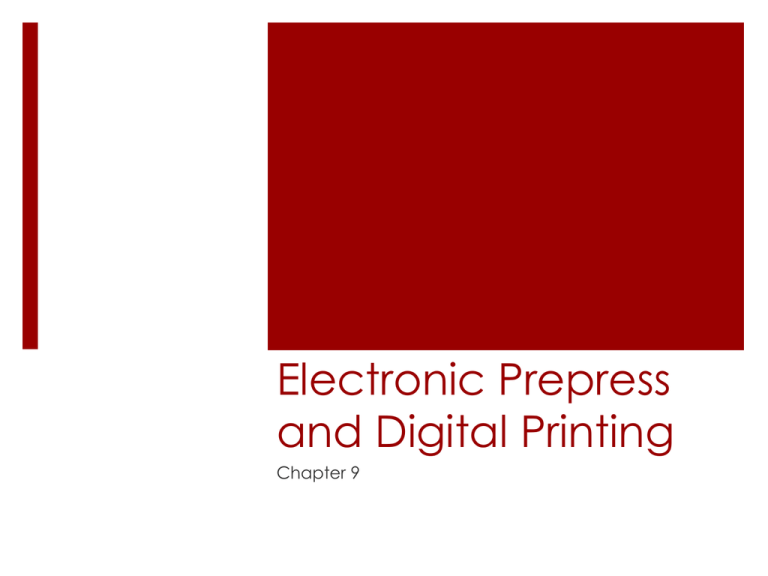
Electronic Prepress and Digital Printing Chapter 9 Computer Platforms The platform of an electronic imaging system is the computer system (hardware) that is used to operate software Word processing Page composition Drawing creation PC (IBM personal computer) Macintosh (Apple) Applications, formats, or devices that work on different platforms are CROSS-PLATFORM Common Hardware Reference Platform (CHRP) Text (Content Creation) Word processing programs Assign codes and format to text Styles or tags Page composition programs Recognizes formats ASCII files (American Standard Code for Information Exchange) Formatting is lost, but text can be repurposed Reusing content intended for one medium by reformatting it for another Transfers data from one computer to another IMPORTANT: Maintain original text and image files Make copies and work from copies Creating Computer Images Paint programs Draw programs Digital photography Electronic scanning Paint Programs Freehand drawings, easily edited Bitmaps or raster graphics Grid of pixels, filled in or empty Enlarging bitmaps creates jagged edges because resolution is reduced (aliasing) Antialiasing diminishes jagged edges, fuzzier Smoothing also reduces jagged edges Draw Programs Vector graphics, object-oriented graphics line defined by start and end point Can be scaled and represented at any resolution (high resolution output) Bezier curve is a vector graphic defined by two endpoints and two or more other points that control shape (anchors, handles) Review Questions 1. What is meant by cross-platform? 2. Reusing content intended for one medium by reformatting it for another is called _______ 3. List four methods that can be used to create computer images 4. What are two methods for diminishing jaggies that should be smooth? Manipulating Images Adobe Photoshop Cropping Color and Contrast Adding or removing visual information Combining images Sharpen, Blur, and Smudge edges Mix, Choose and Apply colors Paint and Draw Clone Apply Filters Create Gradients and Textures Raster Image Processors (RIP) Vector graphics information is transferred from a design workstation to a RIP Hardware-software combination that converts vector images into bitmapped images at selected output resolution View screened files before imaging Supports many font types Offers different dot shapes Can drive multiple output devices simultaneously Interprets and separates color composite files directly High-quality screening technology, reducing moiré patterns Dot-gain calibration Imagesetters Typesetting device used to output fully-paginated text and graphic images at a high resolution onto photographic film, paper or plates Output problems are likely to occur during the transmission of files from the RIP to the imagesetter Uses laser technology to output the page or color separations on the selected medium Manufactured by different companies and differ in speed, precision, resolution, screening technology, and media capability Page Description Languages (PDLs) Serves as the interface between the page composition workstation and the RIP Format by which all the elements to be placed on the page, their respective positions on the page, and the page’s position within the larger document are identified in a manner the output device can understand Adobe PostScript Adobe portable document format (PDF) Hewlett-Packard PCL (Printer Control Language) Adobe PostScript and PDF PostScript Describes the appearance of a page to an output device Interpreter receives PostScript page descriptions and translates them into dot patterns for a printer or pixels for a display PDF Based on the PostScript imaging model Preserves a page’s original layout, type fonts, and graphics as one unit to electronic transfer and viewing Device-independent format- not specifically related to any particular device, converts data without loss of information PDF continued Acrobat Distiller, Acrobat Exchange, Acrobat Catalog, Acrobat Reader Simple, compact, object-oriented files Process quickly, page-independent, self-contained Can be repurposed, downloaded Contains extended job ticket Customer info, proofing directions, trapping, imposition and ripping parameters, finishing and shipping instructions Review Questions 5. List at least five forms of manipulation that are allowed by image editors/image manipulation programs 6. What is a raster image processor (RIP)? What is its major function? 7. What is am imagesetter? What is its major function? 8. What purpose does a page description language (PDL) serve? 9. What is portable document format (PDF) and what are some of its main advantages? 10. What does it mean when a file format is defined as deviceindependent? File Compression Files should be reduced in size before being sent to printers Lossless- no data is lost (PKZIP compression technology or zip files) Unzipping the file will decompress it (.ZIP Self-extracting are unzipped by opening (.EXE) Decompressed image is identical to original Preferred for images that are printed Lossy- some data is lost (quantization, DPCM, and JPEG files) Most video compression technologies Eliminates redundant or unnecessary information JPEG files Joint Photographic Experts Group International data compression standard for continuous-tone digital still images Open-system, cross-platform, cross-device Contains bitmap information only and supports grayscale, RGB, and CMYK color models Should only be used on final images, at maximum quality setting File Formats TIFF or TIF- Tagged Image File Format Lossless or JPEG compression, grayscale, CMYK, RGB, indexed color TIFF/IT-P1- Tagged Image File Format for Image Technology Device-dependent format, Color Electronic Prepress Systems (CEPS) EPS- Encapsulated PostScript Stable and reliable file format WMF- Windows Metafile and PICT- Mac Bitmapped and Object-Oriented images File Formats DCS 1.0 and DCS 2.0-Desktop Color Separations EPS graphic file, bitmapped and object-oriented The Photo CD Compressed photographic images on CD-ROM, raster images GIF- Graphics Interchange Format Raster images, up to 256 colors, data compression File Naming Alpha-numeric characters, no symbols No space at beginning Unique Use appropriate file extensions (.TIFF, .EPS etc.) Storage Devices Disk Storage: hard, floppy, CD-ROM, DVD Storage Tape Memory Cards USB Drives Page Composition Formats pages of text and graphics Gives more control over text flow, kerning, and positioning of graphics Allows importations of many graphic file formats PageMaker, QuarkXPress, InDesign Review Questions 11. What is the main difference between lossless and lossy compression? 12. Which type of compression technique is preferred for images that are to be printed? Why? 13. Name at least four of the commonly used file formats 14. Why is it better to use a page composition program to lay out material than a word-processing program? Preflighting Orderly review of files to identify things that could cause problems at the output or prepress stage Discussion of file format and preparation with the service bureau or printer while the project is still in the design stage Problems with customer-furnished files: Missing or incorrect fonts Missing or incorrect trapping File defined with incorrect color (RGB vs. CMYK) Scans supplied in wrong file format Graphics not linked Incorrectly defined or underdefined bleeds No laser proofs supplied Missing graphics Resolution too high or too low in customer-supplied scans Preflighting Continued Begins with printing out color separations and composite hard copies Can be referred to if problems occur Graphics should be linked Original art should be included if linked files are noneditable Outline software and fonts used, trapping requirements, print specifications, and other pertinent information Font Format and Management Printer should use same fonts used for original page composition Page will change if fonts are substituted Document reflow Bad word or line breaks Loss of kerning and tracking Include fonts in files given to printer Turnaround Time and Proofing Nature and complexity of a job determine turnaround time Review number of proofs Samples for customer and guidelines for press operators Made from digital files, generated from film, or run off on a proof press Iris Proofs- produces four-color proofs from digital file Matchprints- produced from film that will create printing page Bluelines or Diazo Proofs- produced from imageset film Press Proofs- generated with a proof press that produces photomechanical proofs Color Proofs- photographic or photomechanical proofing system Digital Printing Technology Computer-to-plate (CTP) Takes fully-paginated digital materials and exposes information to plates in platesetters or imagesetters without creating film intermediates Long-run projects and short-run projects Digital-to-paper Printing of images directly on the press from electronic files, eliminating preparation of film, plates and ink Quick turnaround, flexibility, and cost-effective four-color short runs Also know as Totally Electronic Printing (TEP) Reimageable or no image carrier for transfer or ink-jet ink or toner to paper, pixels (bitmapped images) Review Questions 15. What is preflighting and why is it so important in prepress production? 16. List five of the most common recurring problems with customerfurnished files 17. What problems can occur if fonts are substituted in a final document file? 18. What are some of the ways in which prepress proofs are generated? 19. What is CTP? 20. What are some of the advantages of totally electronic printing?


